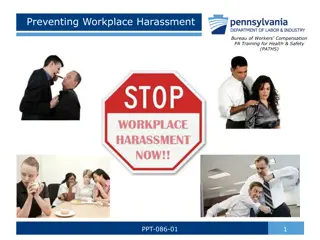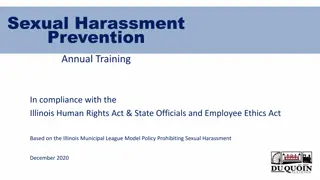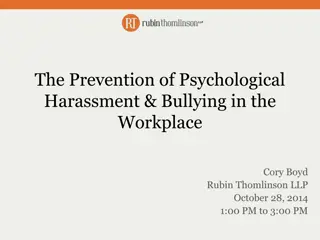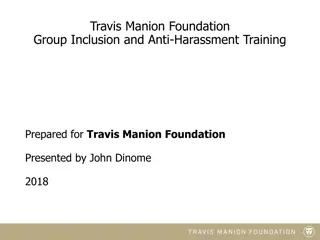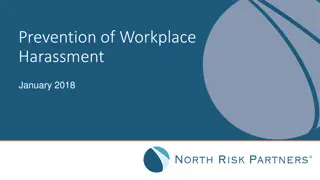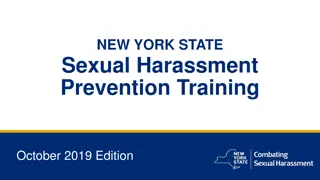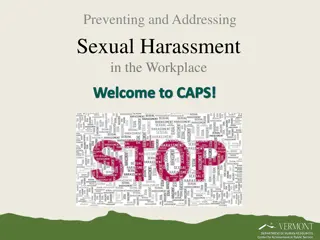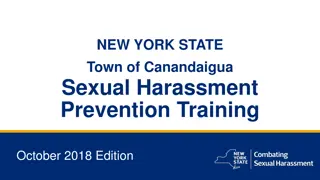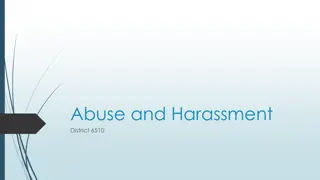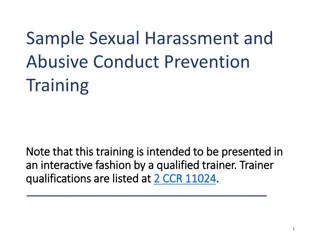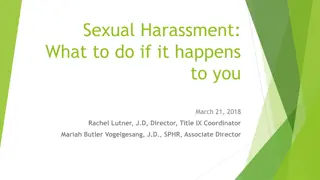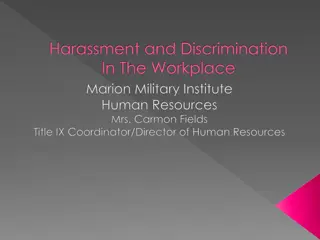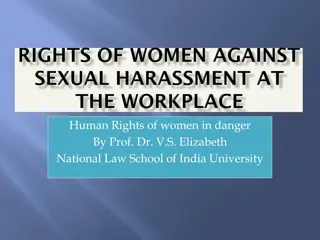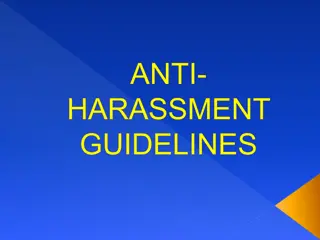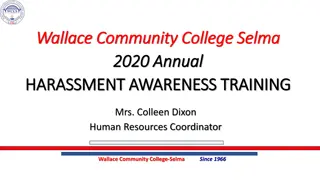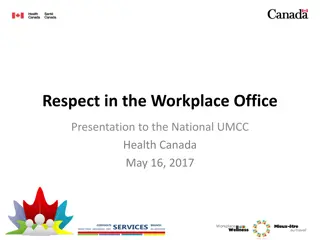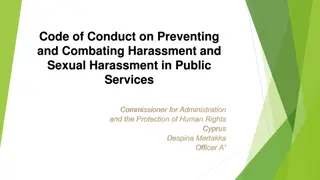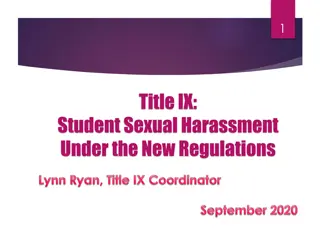Dealing with Workplace Harassment and Uncivil Conduct
The workshop "Detoxify Your Workplace" emphasizes the importance of standing up against workplace harassment and bullying at the University of Toronto. It defines workplace harassment, civil conduct guidelines, and uncivil behaviors, providing examples of each. The material also outlines what actions are not considered uncivil conduct, such as reasonable management actions and respectful interpersonal conflicts. It encourages individuals to address bullies directly and seek support from unions when facing harassment.
Download Presentation

Please find below an Image/Link to download the presentation.
The content on the website is provided AS IS for your information and personal use only. It may not be sold, licensed, or shared on other websites without obtaining consent from the author. Download presentation by click this link. If you encounter any issues during the download, it is possible that the publisher has removed the file from their server.
E N D
Presentation Transcript
DETOXIFY YOUR WORKPLACE Standing Up to Bullying & Harassment at the University of Toronto A USW1998 Workshop
WORKPLACE HARASSMENT Engaging in a course of vexatious comment or conduct against a worker in a workplace that is known or ought reasonably to be known to be unwelcome
CIVIL CONDUCT INCLUDES BREACH OF GUIDELINES Treating others with dignity, courtesy, respect, politeness and consideration Shouting Profanity, abusive, aggressive or violent language directed at an individual or individuals CIVILITY GUIDELINES Speaking in tones of voice that are appropriate for the circumstances Using props suggestive of violence Slamming doors Throwing Objects The University of Toronto s Human Resources Guideline on Civil Conduct constitutes the Workplace Harassment Program as required by the Occupational Health & Safety Act Being respectful of others right to express their views, even if you disagree Humiliating, degrading, demeaning, belittling, insulting, frightening or intimidating another person The guidelines describes what constitutes civil and uncivil conduct, and sets a framework for filing civility complaints Managing conflict with others in a respectful way rather than a confrontational way Distributing comments about a person that are unjustified and likely to have a negative impact if they were to see them Telling inappropriate jokes
NOT EXAMPLES OF UNCIVIL CONDUCT! REASONABLE management actions, such as meetings, letters, or conversations re: performance management, attendance, coaching Instructions given by supervisor/manager re: what to do, how to do it, expected standards of performance Disciplinary action Denial of leave requests Requests for documentation to substantiate leave requests Comments made in the context of peer review processes Differences of opinion or debate conveyed in a RESPECTFUL manner Interpersonal conflicts where the parties remain RESPECTFUL of one another.
IF YOU HAVE A COMPLAINT STICK UP TO THE BULLY CONSULT WITH THE UNION You must make it known to the bully that their behaviour is unwelcome and negatively affecting you Especially re: member on member conflict, going to management or HR may result in punitive action Stick up for your colleagues too. If you see bullying, call it out, name it, demand that it stop SIMS (Steelworker Internal Mediation Program) for non-punitive conflict resolution service But remember there is a fine line between appropriate assertiveness, defending your rights, and insubordination Talk to us before approaching HR. HR is not your friend, they represent management!
ASSERTIVENESS VS. INSUBORDINATION Insubordination Assertiveness Failure to follow a manager s instruction Express concerns clearly, and with confidence. Document it. You can only refuse work if it s unsafe or illegal Don t allow yourself to be taken advantage of. File a grievance or complaint Document your concern about following the directive with an email, while stating your intention to follow management s instructions Always remain respectful and calm Work now, grieve later
AFTER YOU FILE A COMPLAINT There may be an Investigation There will be a University response Complaint details will not be disclosed unless it s necessary to investigate, take corrective action, or is otherwise required by law If a response is not received within 45 days of submitting the written complaint, you can file a grievance at Step 3 Respondents have right to procedural fairness The University may determine there has been no violation, and may opt to simply respond WITHOUT conducting an investigation You will be advised of investigation results, and any correction action taken
RESOURCES Visit http://notinmyworkplace.com Workplace Bullying Institute: http://www.workplacebullying.org/ Contact a steward or the union office for a referral Review the civility guidelines and relevant collective agreement language Lifeline Foundation: Call Sharon Clarke at 416-445-5819 for confidential referral services
FOUR WORKPLACE BULLY TYPES According to Dr. Gary Namie, from the Workplace Bullying Institute Click photo to activate video
THE SCREAMING MIMI Remain calm You seem upset, perhaps we can talk about this later once you ve calmed down? Stand up if you are sitting Take deep breaths, don t act defensively Leave the area if you feel unsafe Document the incident immediately
THE TWO-HEADED SNAKE Build allies and a network of support Don t overshare or be too trusting Two-headed snakes will use information against you Try to feel compassion for the bully, understand their perspective
THE CONSTANT CRITIC Never sign anything you aren t comfortable signing, like a negative performance review Ask to have a union rep present I don t feel comfortable right now. These criticisms aren t fair. This is not constructive feedback. Self care and remind yourself of your competence Be assertive, not insubordinate
THE GATE KEEPER An insidious form of bullying that can be difficult to deal with Politely ask for an explanation and explain negative impact Document in order to clearly demonstrate a pattern of behavior Documentation is key to protect from discipline/performance management




